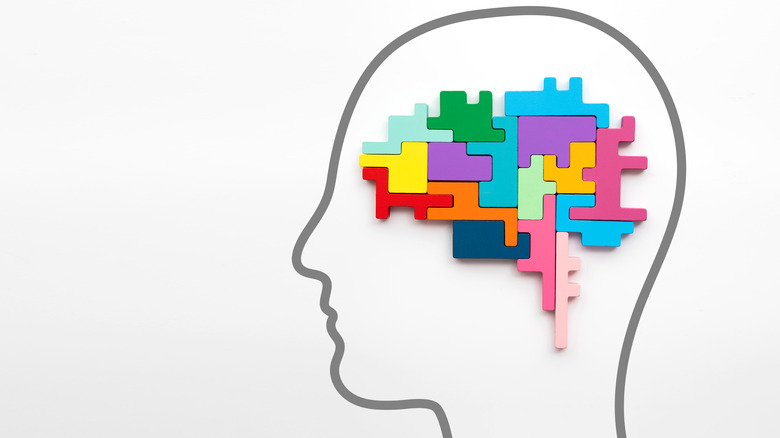What Are The Different Types Of Aphasia?
After a person experiences a stroke or a head injury, they may struggle to speak clearly or may be unable to understand what other people say to them. They are likely experiencing aphasia, a communication disorder that can impair a person's ability to speak, understand others, read, and write words (via WebMD). People living with aphasia often find communication difficult and frustrating. The condition occurs when there is damage to the brain, often because of a stroke, a traumatic brain injury (TBI), a brain tumor, or an infection within the brain. According to Johns Hopkins Medicine, aphasia usually occurs in mid-to-old age and affects men and women equally.
Like many medical conditions, the symptoms and impact on daily life that a person with aphasia experiences can vary based on the type of aphasia with which a person is diagnosed. Sometimes aphasia can be temporary, while other times it's an indefinite occurrence (per Healthline). There are many types of aphasia, all of which are designated by various symptoms, severity, and the location of damage to the brain. Here is what you need to know about the many types of aphasia that can occur.
Brain damage affects the type of aphasia
Since aphasia is a result of brain damage, the key to understanding a person's symptoms and type of aphasia is to be informed about the parts of the brain that control language capabilities. According to Verywell Mind, the brain damage associated with aphasia most often occurs in the dominant hemisphere of the brain, which is the opposite side of a person's dominant hand. Within the dominant hemisphere, there is the temporal lobe, the parietal lobe, and the frontal lobe, all of which control various aspects of a person's language functions.
The temporal lobe processes memories and contains the primary auditory cortex, so if damage occurs in this part of the brain then a person's ability to hear words could be affected (per Science Direct). The parietal lobe controls sensory perception (think of your five senses), and the frontal lobe governs cognitive functions. Damage to these parts of the brain causes various forms of aphasia. For instance, Broca's aphasia is caused by damage to the frontal lobe and leads to difficulty saying short sentences that is often accompanied by weakness or even paralysis of the right side of the body, according to the National Institute on Deafness and Other Communication Disorders. Primary progressive aphasia is a type of aphasia that is the result of degeneration of either the temporal lobe or the frontal lobe, and sometimes both (via Mayo Clinic). It is classified as a form of frontotemporal dementia, although aphasia itself is not dementia.
Fluent vs non-fluent aphasia
There are numerous types of aphasia, and most fall into two categories: fluent and non-fluent (via Healthline). Within these categories are various types of aphasia, which are categorized based on symptoms and which part of the brain has been damaged. The hallmark of fluent aphasia is long sentences with mixed words, and even words that are completely made up. A person with fluent aphasia may not be aware that their words don't make sense, and they may become frustrated when others can't understand them (per MedlinePlus). Wernicke's aphasia is a type of fluent aphasia that stems from damage to the Wernicke's area of the brain located in the temporal lobe, and people with Wernicke's aphasia are known to say long sentences that often don't make sense while simultaneously struggling with comprehension, reports WebMD.
In contrast to fluent aphasia that involves flowing sentences, people who experience non-fluent aphasia strain to say very short sentences of just a few words (via Healthline). Broca's aphasia is a form of non-fluent aphasia that is caused by damage to the Broca's area of the brain located within the frontal lobe, and it is characterized by short sentences that take considerable effort to produce and often omit words. Because the frontal lobe controls motor movements and speech, people with Broca's aphasia also experience difficulty reading and writing.
Mild and severe types of aphasia
Since no brain injury nor type of aphasia are the same, there is a spectrum when it comes to the severity of symptoms and impact on a person's life aphasia may have. According to Science Direct, anomic aphasia is considered to be the mildest form of aphasia. When someone experiences anomic aphasia, they are able to say sentences clearly, but they may struggle to find the correct words when speaking. They are also typically able to comprehend the speech of others and to understand the meanings of words.
Global aphasia is the most severe type of aphasia, reports Healthline. It occurs when a significant amount of the brain is damaged, usually spanning multiple lobes and parts of the brain that control language and cognitive functions. Global aphasia often leaves the person with an inability to produce, comprehend, and write language. When someone has global aphasia, they are sometimes able to say short phrases, but they largely struggle to communicate with others. While global aphasia is usually a long-term condition, there is also transient global aphasia, which can be a temporary form of aphasia that is brought on by seizures, migraines, or transient ischemic attacks (TIA).
In accordance with The National Health Service (NHS), treatments for various types of aphasia can include speech therapy, electrical brain stimulation techniques, medication, and behavioral therapy. There are even apps that can help to improve the symptoms of aphasia.




